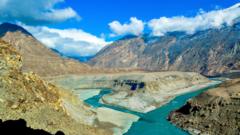India's recent suspension of the Indus Waters Treaty, following a violent attack in Kashmir, has sparked debates on whether the country can and will stop the Indus River's flow into Pakistan. Experts indicate that while India could face logistical challenges in diverting river water, the potential consequences of altering water management in the region could escalate diplomatic tensions significantly.
India’s Water Dilemma: Can it Cut Off the Indus River to Pakistan?

India’s Water Dilemma: Can it Cut Off the Indus River to Pakistan?
The suspension of the Indus Waters Treaty raises questions about India's ability to control river flow into Pakistan amidst rising tensions.
India is grappling with a contentious decision: can it halt the flow of the Indus River and its tributaries into Pakistan? This question emerges following the recent suspension of the Indus Waters Treaty (IWT) instituted in 1960, a pact designed to share water from six rivers in the Indus basin. The treaty has withstood multiple conflicts between the nuclear-armed nations and is often highlighted as a model for transboundary water management.
The suspension came in the wake of a devastating attack in Indian-administered Kashmir, prompting India to accuse Pakistan of sponsoring terrorism—a claim that Pakistan vehemently denies. In retaliation, Islamabad has warned that any attempt to stop water flow would be seen as an act of war. The IWT allocates India the rights to three eastern rivers (Ravi, Beas, and Sutlej) while assigning 80% of the western rivers’ (Indus, Jhelum, and Chenab) usage to Pakistan.
Negotiations have previously been complicated by Pakistan’s complaints about Indian projects believed to threaten river flow, a situation critical for Pakistan’s agricultural and energy needs. After the recent attack, India has indicated a desire to reassess treaty terms to align with its growing requirements for resources in light of climate shifts.
However, experts suggest it may be virtually impossible for India to restrict the flow of water from the western rivers, given the volume of water and the limitations in storage capability. Current hydropower infrastructure in India is primarily run-of-the-river systems, meaning they do not retain significant water supplies, limiting the potential for divestment.
While discussions have circulated regarding developing new storage facilities, there has been little visible progress. Additionally, India’s existing treaty obligations to share hydrological data with Pakistan pose another challenge; however, some officials imply that under the suspension, India could withhold such data, which has significant implications for resource management on both sides.
The tension poses the question of whether water could become a weapon in this ongoing conflict—if India were to utilize its upstream position to impact water availability for Pakistan, it could trigger dire consequences in already vulnerable areas. In particular, impacts could be felt more severely in the dry months when water supply dwindles.
Furthermore, the geopolitical implications are significant; India, located downstream of China on the Brahmaputra, must navigate complex relationships as Beijing has begun construction on major dams that could impact the water supply to northeastern India.
As tensions mount, all eyes are on the India-Pakistan dynamics, with water remaining an essential yet contentious aspect of their geopolitical landscape.



















